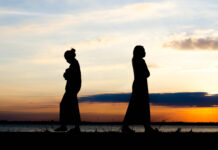It was my first trip to Brooklyn. Wearing a plaid party dress that my grandmother had sewn by hand, I sat up straight with intense anticipation in the school bus carrying my Beth El Hebrew-school classmates. Our rabbi, who taught us third-graders three times a week at our Conservative synagogue, was getting married, and he had generously invited us all to come to his traditional Orthodox Jewish wedding. Another first for me.
We kids loved him. He was that breed of passionate teacher who enjoyed kids and expected results. Never failing to show up in a black suit, a large black kippah atop his slightly balding head, and a smile, he had that rounded look and comfortable stance that made him seem like a favorite uncle. On Tu B’Shevat he gave us fruits that seemed exotic, like the long carob pod that I thought would crack my teeth because it was so hard to bite and chew. He had an endless supply of corny jokes that often poked good-natured fun at teachers and their charges. And the boys would never have thought of putting tacks on his chair, the way they did to one sub. He expertly told stories that made the basics of our heritage come alive, and his jovial manner enabled him to hold our attention more than most teachers did.
As we drove farther and farther from home, the rush-hour traffic spread out ahead of us and the sun inching downward, I clutched a little cloth bag with my phone number in it. Peering out the window, I saw the Williamsburg Bridge looming ahead, a great divide that separated our 1950s suburban split-level homes, well-trimmed lawns, birch trees and forsythia bushes from the piers and rows of tall, densely packed brick buildings in the city skyline.
My best friend from Hebrew school was sitting next to me, sporting banana curls that her mom had carefully twisted in her hair. We joined in the loud, animated chorus of “100 Bottles of Beer on the Wall,” and I sang along until about the 70th bottle.
We chatted during that long ride and wondered what was supposed to happen when we got there. Our wedding experiences were limited. We knew the familiar bars of “Here Comes the Bride”—dum dum de-dum; dum dum de-dum—and sang them in our pretend play. They reminded me of when I was four and my sister Rita was two, and we were flower girls at my uncle Bernard’s wedding. Our grandmother had sewn identical blue satin dresses for us, with short, puffy sleeves, large grosgrain ribbons stitched down the front, and wide satin sashes fashioned around the waist and tied in loopy bows in back.
My parents’ song was “Oh, How We Danced on the Night We Were Wed.” I had twirled to it enough times in our living room, with my mom singing and playing the piano, to be able to hum a few bars for my friends on the bus.
When we finally arrived after what seemed like hours, a sturdy-looking man in a black suit and black hat led us off the bus and into the narrow building. Right away he separated us into two lines, one for boys and one for girls, as if we were dividing into sports teams. It was strange and chaotic for a few moments as the boys were led quickly downstairs and the girls were guided up some steep stairs. We didn’t see the boys for the rest of the evening, until we left. What were they going to do that was different from us?
We girls entered a long, narrow room with a dark wood interior. Only women were there, milling around a long counter laden with fruit, nuts, cakes and drinks. It all had a homey feeling to it, very much unlike the one family wedding I remembered, which had taken place in a huge, extravagantly decorated ballroom with lavish, overflowing trays of food.





















